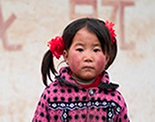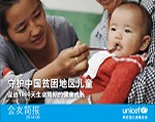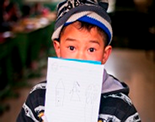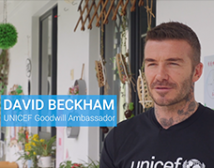By Tanya Accone
Innovation is one of the key ways in which UNICEF accelerates progress for children. We have defined innovation as “doing something new or different that adds value,” so it cannot simply be something that is novel, it must have impact. We don't see innovation as something that is necessarily synonymous with technology, although UNICEF is a leader in mobile phone-based innovation. Innovating in the way we think and work are equally important.
One innovation in Asia Pacific that grabbed my attention is in Mongolia, where winter lasts for five months from November through March and temperatures range between -13 and -45°C.
Like many other children her age, six-year-old Ulziichimeg from the remote northern province of Khuvsgul attends a ‘ger' kindergarten, housed in an insulated, traditional, tent-like structure. While class is warm, using the bathroom could involve a frigid, 100-metre walk to use a dark pit latrine.
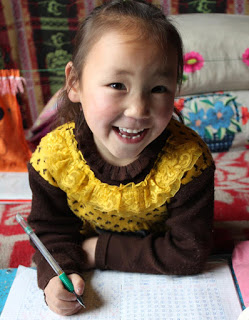 ©UNICEF/UNI180628/Brake ©UNICEF/UNI180628/Brake
Ulziichimeg, 6, is one of the 'reindeer people' who live in Mongolia's Khuvsgul province |
As a mother to a boy not much older than Ulziichimeg, I wasn't surprised to learn that many kindergarteners used all kinds of unhealthy tactics to avoid going to the bathroom, including not drinking enough liquids and constipating themselves.
Remembering how much moaning accompanied my son's getting in and out of multiple layers to go to the bathroom during the winter in New York, I assumed it was because of the cold. But then I learned that there is another, universal reason that the children were uneager to use the outside bathrooms – they were afraid of the dark.
WASH House
Having adequate water, sanitation and hygiene (WASH) facilities in schools is vital to the health and well-being of children, but it is very expensive to build new or rehabilitate old facilities in schools in Mongolia. That is, until the WASH House innovation came along.
This innovation has gone through an iterative process. UNICEF first examined how other industries were using shipping containers for sanitation. We then analyzed the principles of insulated container construction, and used this learning to design five different models and build our own structures. The result is a relocatable ‘WASH House' that is connected to the classroom and provides toilets and basins with warm running water. It is well lit and heated.
The facility can be relocated if required, meaning the bathroom can move with the classroom – for example with a ger kindergarten – which is important for children of nomadic families. The WASH House has been built to connect to groundwater wells and septic tanks, or to existing water supply and sewage infrastructure where these exist.
The houses can be built in bulk inside a warehouse, which is key in a country where the climate limits the period in which construction can be done outside. Fabricating, transporting and installing a WASH House is significantly cheaper than other options in Mongolia. At around USD $16,000, it has attracted interest from private sector donors, as part of their corporate social responsibility. We are also talking to the government about adopting the innovation nationally.
So far, 15 WASH Houses have been installed alongside both ger (tent) kindergartens and regular classrooms, directly benefitting some 1,400 students, from kindergarteners to older students, such as 10-year-old Baljinnyam Batdorj.
 ©UNICEF/Mongolia/Ward ©UNICEF/Mongolia/Ward
Baljinnyam Batdorj, 10, uses the WASH House at Tunel Soum School in Khuvsgul province |
Like many other children from nomadic families in Khuvsgul province, Baljinnyam lives in a dormitory during term time. He is happy with the new facilities because he can now shower whenever he needs to, not only once a week, which was the case before. Teachers at schools with improved sanitation have also noticed that fewer students suffer from diarrhea, colds and flu and fewer are absent from class.
Centre for innovation
Over the past seven years, UNICEF's innovation work largely focused on sub-Saharan Africa. Uganda was the epicenter and I spent months there each year supporting the sharing of proven innovations with leaders from other countries, as well as with other organizations and donors working to improve the lives of children and women.
This year, UNICEF launched a Global Innovation Centre, which identifies successful innovations both from within and outside the organisation, and supports their use across multiple countries and regions. I am one three centre staff on different continents. I am based here in Bangkok because we wanted to strengthen our focus across Asia and the Pacific.
Asia is a very different context from Africa and is both a source of new ideas to learn from, support and share elsewhere, and an opportunity to implement existing ideas in completely new ways. The generally high level of development and infrastructure, for example, means that social media and web chat applications are vastly more important in engaging with youth here.
More than 100 innovations are under development across UNICEF offices in Asia-Pacific, each one closely tied to results for children in that country. The range is extraordinary, including: training young people in digital flood preparedness mapping with Google in Malaysia; designing applications for children with disabilities in China with Tsinghua University; and harnessing solar energy for light and cool classrooms with digital kiosks that provide educational information in remote islands of the Pacific.
We have barely scratched the surface of what is possible with innovation in the Asia-Pacific region, with cold climate innovations like the WASH Houses in Mongolia being just one area that we would like to develop expertise in. There are tremendous resources here, particularly in human ingenuity. There are significant challenges too, including some of the most geographically hard-to-reach and marginalized communities.
I'm looking forward to continuing being a connection in this innovation ecosystem, tracking down and supporting the scale up of proven ideas that make a difference to UNICEF's vital work for children.
The author
Tanya Accone is Senior Adviser on Innovation and Deputy of UNICEF's Global Innovation Centre















